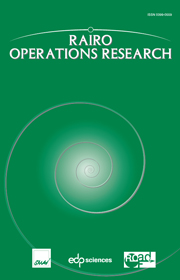No CrossRef data available.
Article contents
Integer programming approaches for minimum stabbingproblems
Published online by Cambridge University Press: 07 March 2014
Abstract
The problem of finding structures with minimum stabbing number has received considerableattention from researchers. Particularly, [10]study the minimum stabbing number of perfect matchings (mspm), spanning trees(msst) and triangulations (mstr) associated to set of points in theplane. The complexity of the mstr remains open whilst the other two are known tobe 𝓝𝓟-hard. This paper presents integer programming(ip) formulations for these three problems, that allowed us to solve them tooptimality through ip branch-and-bound (b&b) or branch-and-cut(b&c) algorithms. Moreover, these models are the basis for the developmentof Lagrangian heuristics. Computational tests were conducted with instances taken from theliterature where the performance of the Lagrangian heuristics were compared with that ofthe exact b&b and b&c algorithms. The results reveal that theLagrangian heuristics yield solutions with minute, and often null, duality gaps forinstances with several hundreds of points in small computation times. To our knowledge,this is the first computational study ever reported in which these three stabbing problemsare considered and where provably optimal solutions are given.
Information
- Type
- Research Article
- Information
- RAIRO - Operations Research , Volume 48 , Issue 2: Isco 2012, guest editors Nelson Maculan, A. Ridha Mahjoub, Eduardo Uchoa , April 2014 , pp. 211 - 233
- Copyright
- © EDP Sciences, ROADEF, SMAI, 2014

